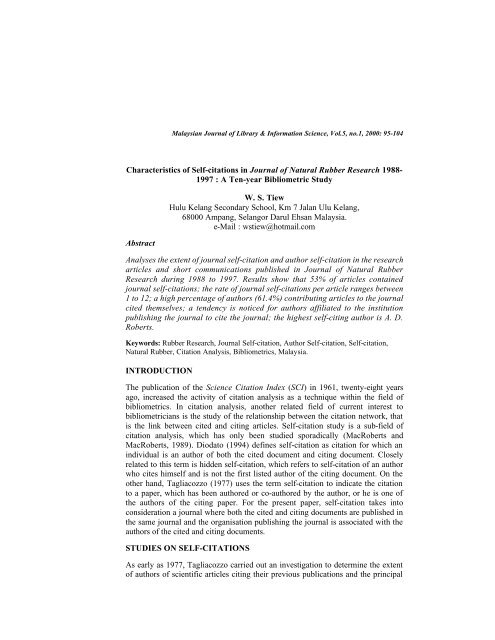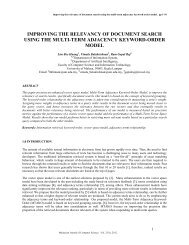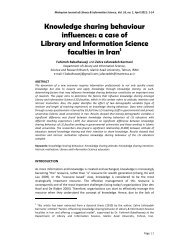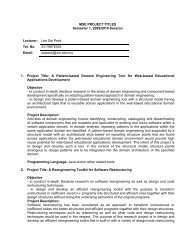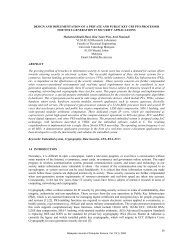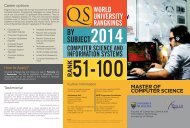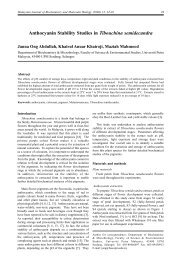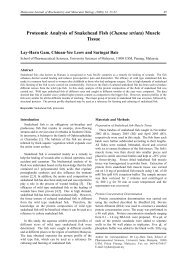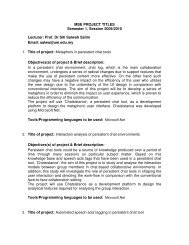You also want an ePaper? Increase the reach of your titles
YUMPU automatically turns print PDFs into web optimized ePapers that Google loves.
Malaysian Journal of Library & Information Science, Vol.5, no.1, 2000: 95-104Characteristics of Self-citations in Journal of Natural Rubber Research 1988-1997 : A Ten-year Bibliometric StudyAbstractW. S. TiewHulu Kelang Secondary School, Km 7 Jalan Ulu Kelang,68000 Ampang, Selangor Darul Ehsan Malaysia.e-Mail : wstiew@hotmail.comAnalyses the extent of journal self-citation and author self-citation in the researcharticles and short communications published in Journal of Natural RubberResearch during 1988 to 1997. Results show that 53% of articles containedjournal self-citations; the rate of journal self-citations per article ranges between1 to 12; a high percentage of authors (61.4%) contributing articles to the journalcited themselves; a tendency is noticed for authors affiliated to the institutionpublishing the journal to cite the journal; the highest self-citing author is A. D.Roberts.Keywords: Rubber Research, Journal Self-citation, Author Self-citation, Self-citation,Natural Rubber, Citation Analysis, Bibliometrics, Malaysia.INTRODUCTIONThe publication of the Science Citation Index (SCI) in 1961, twenty-eight yearsago, increased the activity of citation analysis as a technique within the field ofbibliometrics. In citation analysis, another related field of current interest tobibliometricians is the study of the relationship between the citation network, thatis the link between cited and citing articles. Self-citation study is a sub-field ofcitation analysis, which has only been studied sporadically (MacRoberts andMacRoberts, 1989). Diodato (1994) defines self-citation as citation for which anindividual is an author of both the cited document and citing document. Closelyrelated to this term is hidden self-citation, which refers to self-citation of an authorwho cites himself and is not the first listed author of the citing document. On theother hand, Tagliacozzo (1977) uses the term self-citation to indicate the citationto a paper, which has been authored or co-authored by the author, or he is one ofthe authors of the citing paper. For the present paper, self-citation takes intoconsideration a journal where both the cited and citing documents are published inthe same journal and the organisation publishing the journal is associated with theauthors of the cited and citing documents.STUDIES ON SELF-CITATIONSAs early as 1977, Tagliacozzo carried out an investigation to determine the extentof authors of scientific articles citing their previous publications and the principal
Tiew, W.S.distinguishing features of this particular type of citation. For this purpose, sheanalysed six journals, representing the core journals in plant physiology andneurobiology. The results indicated that self-citations was more recent and citedmore frequently in the text of the citing articles than citations of other authors.There was no indication of any relationship between self-citation and the numberof co-authors and to the size of the bibliography of the citing articles or to theirauthors’ productivity.Kundu (1981) carried out a study on self-citation using citation data obtained fromAnnals of Library Science (afterwards Annals of Library Science andDocumentation) during 1954-1975. He found that out of the 1545 citations, only231 citations (14.9%) were self-citations. He also noted that the top self-citingauthor is none other than the outstanding mahaguru of Indian library andinformation science, S. R. Ranganathan with a count of 174 self-citations.Muskhelishvili, Oganyan and Shreider (1987) undertook to explore self-citationanalysis as a method of research into the shaping of an author’s scientific andphilosophical concepts. They argued that self-citation analysis could reveal thereal order of the author’s thoughts and concepts backed by factual text leading to aparticular scientific discovery. They added that the author’s research findings playa part in the popularisation process together with the author’s participation in theappraisal of his own work.In 1989, Snyder and Bonzi, examined the motivation of authors in citingthemselves and others in their research papers. A total of 13 researchers weresupplied with copies of their research papers where they cited themselves andothers. At the same time, a list of reasons for citing was also given and theresearchers were asked to indicate the appropriate reasons for their citingbehaviour. They found that there were relatively few differences in motivatingfactors for citing themselves and others. Any difference noted was due tointellectual grounds and not self-aggrandisement. Zmaic, Maricic and Simeon(1989) on the other hand, carried out a study to distinguish between hidden selfcitationsand self-citations by primary authors of citing document.Bonzi and Snyder (1990) investigated patterns of self-citation in relation to the useof citations by others. The referencing patterns of authors of four disciplines, twoeach from the physical science and social science were collected and analysed todetermine the number, age of references and pattern of self-citation. They alsostudied the proportion of self-citations to all references and the exposure to selfcitationwithin text compared to other authors.Bonzi and Snyder (1991) again investigated the motivating factors in self-citationof 51 self-citing authors in several natural science disciplines. The results of thesurvey on reasons for both self-citation and citation of others indicated that there96
Characteristics of Self-citation in Journal Of Natural Rubber Researchwere very few differences in motivation and that there were plausible intellectualgrounds for these differences. The study also showed that there was no differencebetween self-citation and citation of others in text.Maczelka and Zsindely (1992) on the other hand, investigated the impact and thejournal self-citation rate of 22 newly launched chemistry journals. Their analysisindicated that the dependence of these indicators on the journal’s age was found tobe characteristics of the initial period of a journal’s life cycle.In 1995, Dimitroff and Arlitsch examined 1058 articles to determine the rate ofself-citation in library and information science literature. They found that 50% ofthe articles contained at least one self-citation. The self-citation rate of 50% ishigher than previous studies of self-citation rates in the sciences and socialsciences. The percentage of self-citation as related to total citation count is only6.6% which falls between the percentage reported in the sciences and other socialsciences. Baldi and Hargens (1995) re-examined the work of Price entitled‘Networks of scientific papers’ to distinguish negative citation and self-citationsfrom other citations in N rays literature. Their study found that both negativecitation and self-citation are prominent in the N rays literature. Pichappan (1995)tried to advocate the use of journal self-citation as crucial bibliometric indicatorsto measure contribution of a journal towards a specialty. He argues that journalself-citation rate can be normalised by adopting a two stage refinement. Thenormalised self-citing rates are also compared with external self-citing rate toknow the self and external influence of journals.As seen from the literature review, self-citation is significant to the world ofcitation analysis. The purpose of this study is to investigate the practice of selfcitationsas observed in the field of natural rubber research as reflected in theJournal of Natural Rubber Research, published by the Rubber Research Instituteof Malaysia, a well-known institution promoting worldwide rubber research.OBJECTIVESThe aims of the study are to find out:(a) the number of articles with journal self-citations by year;(b) the frequency distribution of journal self-citations by year;(c) the frequency distribution of journal self-citations per article;(d) the frequency distribution of journal self-citations by titles;(e) the number of self-citing authors in journal articles;(f) the frequency distribution of self-citing authors in journal articles;(g) the relationship between author affiliation and journal self-citation; and(h) the rank list of self-citing authors.97
Tiew, W.S.SCOPEThe study is based on 258 research articles and short communications and 4177references appended to these articles published in the Journal of Natural RubberResearch 1988-1997. Title pages containing names of authors and theirinstitutional affiliations together with references appended at the end of all thearticles are studied and analysed. Out of 258 articles, 137 articles contain journalself-citations while 196 authors out of 319, self-cited themselves in these articles.METHODOLOGYThe title page and references appended to each article published between 1988-1997 were collected, compiled and scanned to study various aspects pertaining tojournal self-citation and author self-citation. The references were then examined,checked and tabulated for necessary data into separate data sheets to facilitateanalysis of the study in terms of number and frequency of journal self-citations perarticle, year, and title. At the same time, the extent of author self-citation was alsoexamined and tabulated to find out the number and frequency of self-citingauthors, relationship between author affiliation and journal self-citations, andfinally to prepare a rank list of highest self-citing authors.RESULTS AND DISCUSSION1. Frequency Distribution of Articles with Journal Self-citations by YearTable 1 shows the frequency distribution of journal self-citations figured inreferences appended to articles published in the journal between the years 1988-1997. The years 1989 and 1996 scored the highest with 16 articles each havingjournal self-citations. On the whole, over a ten-year period, journal self-citationsoccurred in as many as 137 articles out of a total of 258 articles, meaning that 53%of the contributions to the journal contained journal self-citations.Table 1: Frequency Distribution of Articles with Journal Self-citationsYear Number of Articleswith self-citationsNumber of Articleswithout self-citationsTotal Number ofArticles1988 14 13 271989 16 11 271990 13 14 271991 12 14 261992 13 11 241993 14 15 291994 14 14 281995 13 10 231996 16 7 231997 12 12 24Total 137 121 25898
Characteristics of Self-citation in Journal Of Natural Rubber Research2. Frequency Distribution of Journal Self-citations Per ArticleTable 2 indicates the frequency distribution of journal self-citations per article.Most of the articles (40.2%) had at least one journal self-citation. Articles withtwo journal self-citations (24.8%) occupy second place and articles with threejournal self-citations (16.8%) occupy the third place. The rest of the articlesreceived between four and twelve journal self-citations each.Table 2: Frequency Distribution of Journal Self-citations Per ArticleFrequency of Journal Number of Articles with PercentageSelf-citations Journal Self-citations1 55 40.22 34 24.83 23 16.84 10 7.35 2 1.56 4 2.97 0 0.08 3 2.29 1 0.710 3 2.211 1 0.712 1 0.7Total 137 1003. Frequency Distribution of Journal Self-citations by YearTable 3 shows the frequency distribution of journal self-citations by year. The datareveals that 1989 scored the highest number of journal self-citations with a total of51 (14.2%). Over a ten-year period, a total of 352 journal self-citations occurred ina total of 4177 references. The mean score of journal self-citation is 8.4.Table 3: Frequency Distribution of Journal Self-citations by YearYear Total Number ofJournal Self-citationsTotal Numberof ReferencesPercentage ofJournal Self-citations1988 31 466 6.61989 51 359 14.21990 33 401 8.21991 24 448 5.31992 28 481 5.81993 30 396 7.61994 22 429 5.11995 56 475 11.81996 51 426 12.01997 26 296 8.8Total 352 4177 8.499
Tiew, W.S.4. Frequency Distribution of Journal Self-citations by TitlesTable 4 reveals the frequency distribution of journal self-citations by titlespublished in the Rubber Research Institute of Malaysia between 1929 to 1997.The Journal of Natural Rubber Research is actually the continuation of QuarterlyJournal of Rubber Research Institute of Malaya which first appeared in 1929.Later, in 1931 the journal was renamed as Journal of the Rubber ResearchInstitute of Malaya and in 1974 the journal assumed the title Journal of the RubberResearch Institute of Malaysia. Finally, in 1986, the journal was published underthe title Journal of Natural Rubber Research. Out of a total of 352 journal selfcitations,173 (49.1%) were to Journal of Natural Rubber Research, 97 (27.6%) toJournal of the Rubber Research Institute of Malaya, 80 (22.7%) to Journal of theRubber Research Institute of Malaysia and 2 (0.6%) to Quarterly Journal ofRubber Research Institute of Malaya. Most of the articles contained self-citationsof more recent issues compared to earlier publications. In other words, the worldof rubber research is keeping itself abreast.YearTable 4: Frequency Distribution of Journal Self-citations by TitleQuarterlyJournal ofRubber ResearchInstitute ofMalaya1929-1930Journal of theRubberResearchInstitute ofMalaya1931-1973Journal of theRubberResearchInstitute ofMalaysia1974-1985Journal ofNaturalRubberResearch1986-1997TotalNumberofJournalSelfcitations1988 - 12 7 12 311989 - 21 16 14 511990 2 11 8 12 331991 - 6 2 16 241992 - 10 8 10 281993 - 2 8 20 301994 - - 1 21 221995 - 18 16 22 561996 - 16 11 24 511997 - 1 3 22 26Total 2 97 80 173 352% 0.6 27.6 22.7 49.1 1005. Self-citing Authors in JournalThe results indicate the presence of self-citing authors in the references publishedin articles of the journal. A total of 196 (61.4%) authors cited themselves in theirarticles compared to 123 (38.6%) authors who did not cite themselves. Hence, thehigh percentage of self-citing authors clearly indicates that the authors of thisjournal have the tendency to cite themselves.100
Characteristics of Self-citation in Journal Of Natural Rubber ResearchVI.Frequency Distribution of Self-citing AuthorsTable 5 reveals the frequency distribution of self-citing authors in the referencesappended to the journal’s articles. Out of a total of 196 self-citing authors, 65(33.2%) authors cite themselves only once in their articles while 45 (23%) authorscite twice followed by 28 (14.3%) authors who cite themselves three times. Therest cite themselves between four and 39 times. The highest number of selfcitationsby an author who cited himself is 61 times.Table 5: Frequency Distribution of Self-citing AuthorsFrequency of Number of Author PercentageSelf-citing Authors1 65 33.22 45 23.03 28 14.34 7 3.65 7 3.66 7 3.67 7 3.68 5 2.59 8 4.110 2 1.011 4 2.013 3 1.518 3 1.522 1 0.526 1 0.527 1 0.539 1 0.561 1 0.5Total 196 1007. Author Affiliation and Journal Self-citationsTable 6 reveals the relationship between author affiliation and journal selfcitations.Out of a total of 352 journal self-citations, 171(48.6%) are cited by thestaff of the Rubber Research Institute of Malaysia which published the journalunder study. A total of 63 journal self-citation are cited by staff of RubberResearch Institute of Malaysia collaborating with others in their research. On theother hand, 118 (33.5%) are cited by researchers not related to Rubber ResearchInstitute of Malaysia. The staff of the organisation publishing the journal has thetendency to self-cite their own journal (66.5%).101
Tiew, W.S.Table 6: Author Affiliation and Journal Self-citationsYear Staff Staff & Others Non-staff Total1988 14 2 15 311989 35 8 8 511990 25 1 7 331991 8 1 15 241992 15 1 12 281993 15 3 12 301994 6 9 7 221995 27 9 20 561996 19 22 10 511997 7 7 12 26Total 171 63 118 352% 48.6 17.9 33.5 1008. Rank List of Self-citing AuthorsTable 7 shows the list of self-citing authors in decreasing order of self-citations. A.D. Roberts of the Malaysia Rubber Producers’ Research Association based inLondon scored the highest (61) followed by Yeang Hoong Yeet of RubberResearch Institute of Malaysia with 39. In third place is Gerald Scott (27) fromAston University, United Kingdom. Here, it should be noted that Gerald Scott alsoheld the record of self-citing himself as many as 27 times in a single article. Onthe whole, it can be deduced that most researchers affiliated with MalaysianRubber Producers’ Research Association (5) and Rubber Research Institute ofMalaysia (5) self-cited themselves in their research articles.RankName ofAuthorTable 8: Rank List of Self-citing AuthorsInstitutional AffiliationFre. ofSelfcitationsCum.Total1 Roberts, A. D. Malaysian Rubber Producers’ Research Association 61 612 Yeang, H. Y. Rubber Research Institute of Malaysia 39 1003 Scott, Gerald Department of Chemical Engineering and Applied 27 127Chemistry, Aston University, United Kingdom4 Tinker, A. J. Malaysian Rubber Producers’ Research Association 26 1535 Gomez, J. B. Rubber Research Institute of Malaysia 22 1756 Gelling, I. R. Malaysian Rubber Producers’ Research Association 18 1937 Ikram, A. Rubber Research Institute of Malaysia 18 2118 Yip, Esah Rubber Research Institute of Malaysia 18 2299 Bristow, G. M. Malaysian Rubber Producers’ Research Association 13 24210 Campbell, D. S. Malaysian Rubber Producers’ Research Association 13 25511 Lau, Chee Heng Rubber Research Institute of Malaysia 13 268102
Characteristics of Self-citation in Journal Of Natural Rubber ResearchSUMMARY AND CONCLUSIONSThe findings of the study can be summarised as below:The number of articles containing journal self-citation is slightly over 50%. Thiscould indicate that the journal studied is scholarly and well-known in the field ofrubber research and, hence, frequently referred to in this field of study.The range of journal self-citations per article is between one and twelve.Of the4177 references only 352 (8.4%) are journal self-citations. This is slightly abovethe self-citation rate of 5% found by Tagliacozzo (1977) in areas of social scienceand 10%-20% in the sciences.As the journal under study was published with different titles at different times, itis found that more journal self-citations are to the present title.A high percentage of authors (61.4%) who had contributed articles to the journalcited themselves indicating a high probability that future contributing authorswould likely cite themselves too. On the other hand, the high percentage ofauthors who cited themselves could indicate the existence of a series of continuousresearch being conducted by the respective researchers in their field of study andthe results are published in the source journal studied. The frequency distributionof author self-citation is between one and 61 times.It is found that more than 50% of the authors contributing articles to the journalare affiliated to the institution publishing the journal. The close link between theauthor affiliation and the institution publishing the journal probably influenced theextent of journal self-citation in the articles.The highest self-citing author is A. D. Roberts, affiliated to the Malaysian RubberProducers’ Research Association.There were inconsistencies in the citing of certain Chinese and Malay authors’names and may create problems when analysing data, as more time and care areneeded to examine these names. For example, the Malay names Mohd. Zin Ab.Karim, Mohd. Zin Karim and Karim, M. Z. refers to the same author but citeddifferently by the author himself in articles. Another example is Lau, C. H. andLau, Chee Heng, which refer to the same person who is being cited. Thisinconsistency could be a avoided by a more stringent instruction to authors in theeditorial policyACKNOWLEDGEMENTThe author is thankful to Professor B. K. Sen, formerly attached to the Faculty ofComputer Science and Information Technology, University of Malaya, for hisguidance and meaningful discussion during the preparation of this paper. Also toPuan Fauziah bt Abdul Rahman, Chief Librarian of RRIM’s Library and her stafffor providing necessary facilities during the preparation of the paper.103
Tiew, W.S.REFERENCESBaldi, S. and L. L. Hargens. 1995. Reassessing the N rays reference network : therole of self-citation and negative citation. Scientometrics, Vol. 34 no. 2 : 239-253.Bonzi, Susan and H.W.Snyder. 1990. Pattern of self-citation across fields ofenquiry. In : Diane Henderson ed. ASIS’90. Information in the year 2000 :from research to applications. Proceedings of the 53rd Annual Meeting of theAmerican Society for Information Science, Toronto, Canada.4-8 November1990. Vol. 27. Medford, N.J.: Learned Information : 204-207.Bonzi, Susan and H. W. Snyder. 1991. Motivations of citation : a comparision ofself citation and citation to others. Scientometrics, Vol. 21 no. 2 : 245-254.Dimitroff, A. and K. Arlitsch 1995. Self-citations in the library and informationscience literature. Journal of Documentation, Vol. 51 no. 1 : 44-56.Diodato, Virgil. 1994. Dictionary of bibliometrics. New York : Haworth Press.Kundu, A. K. 1981. Self-citations in Indian library literature. Annals of LibraryScience and Documentation, Vol. 28, no. 1-4 : 39-41.MacRoberts, Micheal H. and Barbara R. MacRoberts. 1989. Problems of citationanalysis: a critical review. Journal of the American Society for InformationScience, Vol. 40 no 5 : 342-349.Maczelka, H. and S. Zsindely 1992. All well if starts well? Citation infancy ofrecentlylaunched chemistry journals. Scientometrics, Vol. 25 no. 2 : 367-372.Muskhelishvili, N. L., E. A. Oganyan and Yu A. Shreider. 1987. Analysis of selfcitation as amethod of research into the shaping of author’s scientific andphilosophical concepts.(Russian). Nauchno-Tekhnicheskaya Informatsiya,Series 2 no 12 : 10-15.Pichappan, P. 1995. A dual refinement of journal self-citation measures.Scientometrics, Vol. 33 no. 1 : 13-21.Snyder, Herbert W. and Susan Bonzi. 1989. An enquiry into the behavior ofauthor self citation. In : Jeffrey Katzer and Gregory B. Newby eds. ASIS’89.Managing information and technology. Proceedings of the 52 nd AnnualMeeting of the American Society for Information Science. Washington, D. C.,30 th October-2 nd November 1989. Vol.26. Medford, N.J.: Learned Information: 147-151.Tagliacozzo, Renata. 1977. Self-citations in scientific literature, Journal ofDocumentation,Vol. 33 no. 4 : 251-265.Zmiac, L., S. Maricic and V. Simeon. 1989. Visibility of peripheral journalsthrough the Science Citation Index, Information Processing and Management,Vol. 25 : 713-719.104


